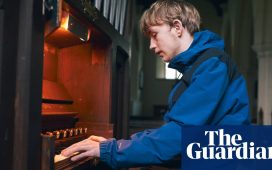Right now, I am in the throes of what I call festive anxiety: that limited-edition, special form of anxiety that hits anyone in charge of gift-giving around the holiday season, magnified by the excess of pointless toys that are marketed to kids this time of year.
Festive anxiety hits me hard: not just because of the work involved, but because a recent survey from eco-retailer Flora and Fauna suggested that despite an average spend of $1bn on new toys at Christmas, Australians still bin 26.8m toys every year.
The oft-touted cure to this is the educational toy, which fulfils a dual purpose – entertaining the child, while setting the parents’ minds at ease. But do kids actually need “educational toys”, and do those toys actually do what they say they will?
Not necessarily, says paediatric psychologist Deirdre Brandner, who believes that toy manufacturers can play into the vulnerability of parents who “overanalyse every decision” in the pursuit of giving children the best opportunities they can.
“Whilst many [manufacturers] produce items that are a fantastic opportunity for positive engagement and learning, the same can be said for any household object,” she says. “A variety of experiences, toys, interaction with children and engagement of parents in a child’s play has much better learning outcomes.”
She says that there hasn’t been valid or sustained research that suggests that any particular toys can result in improved learning outcomes, and advises parents to reconsider setting up play “with an expectation that it has to be about a specific outcome”.
“Playing with toys is the first chance that a child has to explore and interact with the world on their terms,” she explains. “It is the experience of play that produces learning outcomes, toys are just the medium through which children discover, engage, create and problem-solve.”
Brandner warns against attaching too many rules to play, which is part of a child’s natural cognitive, social and emotional development. She says that the only rules for play should be those that keep them safe and allow for positive interactions with their peers, enabling them to develop skills such as decision-making, contextualising, turn-taking and coping with winning and losing.
“Play is about a process and open-ended play will allow the child to have autonomy over the outcome,” she says. “Children need play to be fun or else it isn’t play, it’s work.”
Parents might be comforted to know that play can also be the “foundation of all later learning, including schooling success”, according to child development scientist Dr Siobhan Kennedy-Costantini, who operates Science Minded to help parents better understand their child’s cognitive and social development. She says that while they can be intertwined, play and learning do not have to be mutually exclusive, with academic pursuits replacing play (or vice versa).
“Play supports all types of learning,” she explains. “Physical play, for example, helps develop our vestibular system, which helps us control our bodies. A well-developed vestibular system is essential for school-readiness.” She says “time or experience learning to move or control their bodies by jumping on trampolines or swinging on monkey bars” is very helpful.
Without this kind of physical development, she says, children can struggle with complicated classroom tasks such as activating their core to sit upright at a desk while executing the fine-motor task of writing.
If parents are particularly keen on some sort of tangible element to their child’s play, especially when they’re older, then Brandner suggests toys with open-ended outcomes and varying results. She says that Lego is a perfect example, because “there needs to be a balance between creating your own ideas using Lego and following instructions for build”.
Kennedy-Costantini says that it’s important to remember that humans have evolved over thousands of years through playful behaviour, and encouraging a child’s own play helps them make sense of their world.
“Play is not frivolous,” she explains. “In play, children are testing and refining theories, making connections, understanding relationships and figuring out how the world works.”
Jayne Pavic, who founded toy store Monti and Me to help adults see the purpose in play after becoming a mother herself, agrees, arguing that “it’s impossible to play without learning”.
“I think we need to redefine for adults what learning and play looks like,” she says. “If adults reframe everyday moments as brain building experiences – which they are – the emphasis on specific outcomes of toys becomes less relevant.”
Despite selling toys, she insists “children can play longer and more happily with less toys”.
Brandner says that investing in your child’s play through your time and attention can be a profound way of understanding how beneficial play can be, just for play’s sake.
“A child’s life is going to be filled with many educational and learning opportunities,” she says. “Let’s not derail their enjoyment of play by putting constraints around it.”














